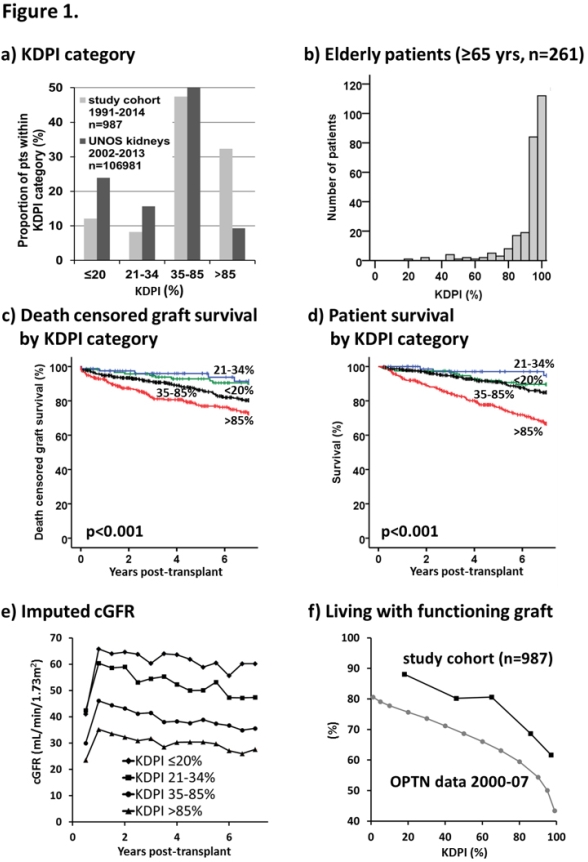KDPI Outcomes and Discard Rates – The Contradiction of the U.S. and European Approach.
Dept. of Nephrology CCM, Charite Berlin, Berlin, Germany.
Meeting: 2016 American Transplant Congress
Abstract number: C63
Keywords: Allocation, Kidney transplantation, Outcome, Public policy
Session Information
Session Name: Poster Session C: Economics, Public Policy, Allocation, Ethics
Session Type: Poster Session
Date: Monday, June 13, 2016
Session Time: 6:00pm-7:00pm
 Presentation Time: 6:00pm-7:00pm
Presentation Time: 6:00pm-7:00pm
Location: Halls C&D
Introduction: Only a few data exist on the KDPI in European patients (pts). We evaluated the influence of donor factors assessed by the KDPI on long-term outcomes in a European cohort including a large proportion of elderly donors and recipients.
Methods: In this retrospective single center study we analyzed 987 adult kidney transplant recipients (KTR) from 1991-2014. KDPI was calculated using OPTN data from 2014 as reference and outcomes were assessed over a period of up to 23 years post-transplant.
Results: The proportion of high KDPI kidneys in our cohort (transplanted within the Eurotransplant Senior program) was significantly higher than in the US cohort 2002-13 (Fig 1a). Median KDPI was 66 %. Notably, the median KDPI (97%) in the elderly (261 pts ≥65 years) was very high (Fig 1b). 62% of the elderly pts received a kidney with a KDPI>95%. Discard rate of these organs were 72% in the US 2012-14.
After 5 years the rate of patients living with functioning graft was 76.0% and graft survival censored for death 85.1%. KTR of higher KDPI kidneys were significantly older and had significantly higher mortality, inferiror graft survival and lower cGFR (Fig 1 c-e). Elderly KTR receiving very high KDPI kidneys (≥99%) still had satisfactory graft survival rates (at 3 yrs 85%, 5 yrs 73%). The rate of living pts with functioning graft at 5 yrs exceeded the matched OPTN US data despite a higher proportion of elderly pts in our cohort (>65 yrs 26% vs 15%) (Fig 1f). Multivariate analysis and c-statistic revealed KDPI (HR 1.14 per 10%, p<0.001) as the most relevant independent donor factor predicting graft loss.
Conclusion: KDPI score is a reliable predictor of graft outcome. Although the European cohort was disadvantaged by both higher recipient age and higher KDPI long term outcomes exceed the US results. In Europe elderly KTR received many kidneys procured from donors with very high KDPI, nevertheless outcomes were acceptable. KDPI may be a valuable tool to optimize allocation, however our results demonstrate that even kidney with very high KDPI scores can be utilized.

CITATION INFORMATION: Lehner L, Kleinsteuber A, Halleck F, Khadzhynov D, Duerr M, Budde K, Staeck O. KDPI Outcomes and Discard Rates – The Contradiction of the U.S. and European Approach. Am J Transplant. 2016;16 (suppl 3).
To cite this abstract in AMA style:
Lehner L, Kleinsteuber A, Halleck F, Khadzhynov D, Duerr M, Budde K, Staeck O. KDPI Outcomes and Discard Rates – The Contradiction of the U.S. and European Approach. [abstract]. Am J Transplant. 2016; 16 (suppl 3). https://atcmeetingabstracts.com/abstract/kdpi-outcomes-and-discard-rates-the-contradiction-of-the-u-s-and-european-approach/. Accessed January 8, 2026.« Back to 2016 American Transplant Congress
